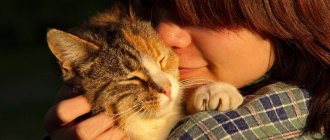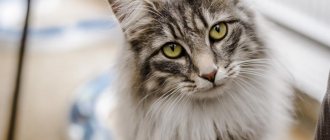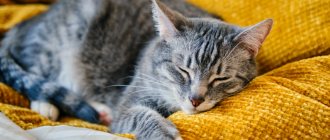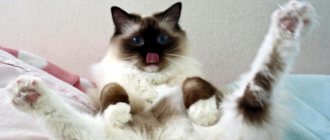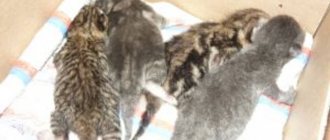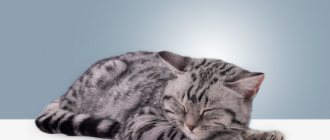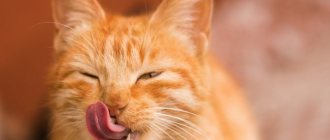Cats are amazing creatures, such familiar animals that have lived next to us for several millennia, conceal quite a few secrets, and there are also a huge number of myths and legends around them. Their behavior is sometimes completely incomprehensible and raises many questions. For example, the usual trampling of our paws, what causes it? Why do cats start doing this massage?
You? finally? Fulfilled a dream and got a pet. They decided how and what to feed him and trained him to use the tray. The cat is already spending time with you with great pleasure: playing, sleeping next to you, talking in his cat language. Some, of course, are very freedom-loving and do not like tight hugs, but you have noticed that from time to time your pet moves its paws. What does it mean when a cat gives a massage?
A cat paw massage is an expression of love.
Most often, experienced owners note that the cat gives a massage in a state of “nirvana”, when the pet is completely relaxed and peaceful. Most often, a soft surface is chosen for the milk step - a blanket, toy, pillow or the lap of a beloved owner. Some cats make these movements harmlessly - without extending their claws, but there are those who extend them to their full length.
So, why do cats massage? There are actually many reasons; this movement can be caused by both physiological and psychological factors, as well as instinctive ones. To understand your pet even better, you should familiarize yourself with them.
When the phenomenon is observed
The owner most often observes the peculiar behavior of a domestic cat when the animal is in a peaceful and calm state. At this moment, the pet may purr. Some cats perform the ritual without releasing their claws.
Other individuals can crush the soft surface, extending their claws to their full length. At the same time, the animal looks concentrated, the reaction to external stimuli becomes minimal. Some owners compare this state of their pet to nirvana.
Many cat breeders note that the cat ritual usually takes place on a soft and pliable surface: a blanket, a mattress, the owner’s lap. A hard surface is not suitable for such purposes. Often the “milk step” is used in relation to a soft toy.
Most often, a cat crushes a soft object with its paws when it is about to rest or sleep. Expectant mothers begin to prepare the nest for childbirth and offspring, often before an important event they begin to knead the blanket with their paws. Pets love to perform such a mysterious action when they are on the lap of their beloved owner. Fans of cats note that a cat performs such a ritual only with its owner; such affection is not available to a stranger.
To learn about what a “milk step” is in cats, watch this video:
[custom_ads_shortcode1]
Romantic version
Happy owners of meowing and purring pets value them for the coziness and comfort they bring to their home.
Those moments are especially blissful and peaceful when a pet, in a fit of tenderness and devotion, jumps into the owner’s arms and methodically tramples with its front paws. Except, of course, for situations when an animal uses its claws, having forgotten itself and become carried away by the “massage” process. The most romantic and emotional cat owners explain these habits of their pets by their sincere affection and expression of gratitude and love to their owner. This version is the most difficult to confirm, since reliable methods for studying the emotions of cats (if they exist) have not yet been invented. But besides this version, there are many more options for explaining the behavior of cat “masseurs”.
Probable Causes
Experts in the field of animal psychology identify several reasons why cats knead their paws. This ritual has the following explanations and theories:
It is for this reason that cat breeders call this ritual the “milk step.” Owners often notice that the kitten not only wiggles its paws, but also purrs contentedly and even drools with pleasure. This theory is supported by the fact that artificially fed pets are not capable of the “milk step”.
- One of the reasons why cats paw is their natural instincts. Being once wild predators, animals carefully prepared places for rest and overnight: they trampled down hard grass, making the nest cozy and soft. In the wild, representatives of the cat family use grass and leaves to make a nest. To make your sleeping area comfortable and safe, it needs to be put in order. The most convenient way to do this is to crush objects with your paws.
The desire to equip one’s territory, a place to rest and sleep, is also characteristic of modern domestic couch potatoes. And although most pets live in comfortable conditions, nevertheless, they have not lost the ancient instinct of their wild ancestors. In addition, the cat often crushes soft objects with its paws, arranging a nest for birth and future offspring. Often this behavior is a sign of impending labor.
- Hunting instinct. Some experts believe that domestic cats knead a soft surface, obeying the ancient hunting instinct. Predators by nature, pets have not lost the ancient skills of this skill. Their wild counterparts, before jumping on the prey, crush the surface with their paws, testing it for stability and hardness. It is important for a predator that at a crucial moment a branch does not snap under its paw. Fluffy couch potatoes have not lost their natural instincts, but they do not always use them for their intended purpose.
- Territorial version. Some zoologists are inclined to believe that the reason why cats crush their owners' paws is their desire to mark their territory. There are specific glands on the pads of cats' paws, with the help of which they identify their possessions and territory.
Considering its beloved owner to be its property, the animal leaves its scent on his body, making it clear to other individuals that they can no longer have the right to the owner’s attention. Thus, the ritual serves as a kind of marker to mark one’s property and possessions.
- Psychological release. The psycho-emotional tension or stress accumulated by the pet requires release. Some animal psychologists, not without reason, believe that the reason why cats knead the blanket with their paws is self-soothing. At the same time, the animal practically disconnects from the outside world and focuses on its internal sensations. Monotonous paw movements and purring help calm the pet.
This point of view is supported by the fact that during the “milk step” the cat’s body produces endorphins - specific substances, hormones of happiness. They reduce anxiety and fear in pets.
- Other factors. Experienced breeders believe that the reason for the cat ritual is a high degree of trust and love for its owner. Many cat fans believe that animals perform such a ritual for a healing purpose - they treat their owner from various ailments, taking away negative energy.
Another reason why cats massage their paws is sexual behavior. As a rule, in the spring, with increasing daylight hours, the production of sex hormones increases, which in some individuals is accompanied by a “milk step”. The variety of theories, versions and guesses regarding a peculiar ritual inherent only to representatives of the feline family once again testifies to the mystery and enigma of domestic cats.
None And here is more information about how to remove a cat from a tree yourself and with the help of special services.
[custom_ads_shortcode2]
Indications for the procedure
Cats normally defecate once a day. Animals over 7 years old go to the toilet approximately once every 2 days. If there is no bowel movement for more than 3 days, the cat is constipated.
Typical symptoms:
- restless behavior;
- lethargy;
- refusal of food;
- bloating.
When constipated, the pet sits in the litter box and strains, but does not defecate. Sometimes dry and hard feces are passed in small quantities. However, this does not solve the problem.
You can help your pet yourself. Massage during constipation improves the functioning of the gastrointestinal tract, increases the elasticity of the walls and enhances intestinal motility, which stimulates the release of feces.
Important. If measures are not taken, the body will no longer cope with decay products, the load on the heart will increase, and the functioning of the liver and kidneys will worsen. All this leads to serious complications, including death.
All this leads to serious complications, including death.
Massage is performed for the following problems:
- Constipation due to stress. If the cause is eliminated in a timely manner, massage will normalize bowel movements without the use of medications.
- Chronic constipation. Stool disorders will appear much less frequently. It will be possible to reduce the dosage of medications or stop taking them altogether.
- Constipation in a cat due to a sedentary lifestyle. Typically seen in older animals who become less active.
- Constipation due to changes in diet or poor diet. Difficulty defecating is caused by insufficient fiber intake or a sudden change in food.
- Constipation in obesity. In overweight cats, metabolic processes slow down, which leads to the appearance of dry feces and untimely bowel movements.
It is useful to do massage after birth if the cat has no complications and is in satisfactory condition. The procedure speeds up the recovery of the body and prevents the occurrence of mastitis and other diseases.
If, in addition to constipation, your cat has a fever (above 39.5°C) and vomiting, you should immediately contact your veterinarian. Most likely, she has some serious illness.
Massage is a safe and effective procedure that acts in several directions at once:
- strengthens and tones the abdominal muscles;
- stimulates the movement of feces;
- activates lymph flow and blood circulation;
- relieves pain;
- eliminates spasms;
- reduces gas formation.
Massage is useful even if there is no constipation. It helps to establish a trusting relationship with your pet. Tactile contact brings people closer together and relaxes them. And if you follow the technique, the procedure will be pleasant for the cat.
Massage is used to treat constipation when the cat’s general condition does not cause concern. The procedure is not carried out:
- for dermatological diseases and skin damage on the abdomen;
- inflammatory diseases of the musculoskeletal system;
- colitis, gastritis and other gastrointestinal diseases;
- spasms of the large intestine;
- suspected benign or malignant tumor;
- intestinal hernia or tumor;
- volvulus;
- exhaustion of the cat’s body;
- blockage of the intestine by a foreign body;
- during pregnancy.
After abdominal operations (caesarean section, sterilization), massage is not performed for 6 months.
Constipation sometimes occurs in cats that have broken their pelvic bones. Improper fusion of bones or adhesions leads to defecation problems. To understand the cause, an x-ray is first taken.
Belly massage is also recommended for kittens and older cats. However, it is better to consult a veterinarian first. Excessive or awkward movements can injure your pet.
Should I be scolded for such behavior?
Understanding why cats knead the blanket with their paws, the owner should under no circumstances punish the pet for displaying natural instincts. You should be understanding of the complex and peculiar behavior of the cat. Negative emotions, irritating intonations, and being thrown off your knees during the “milk step” can lead to stress and the development of a negative psycho-emotional state. The animal will stop trusting the person and will withdraw from communication with him.
The owner may not like the fact that the cat crumples his body due to the fact that some individuals can release their claws and injure him. In this case, it is advisable to keep a thick towel or small blanket nearby to lay on your lap. This will protect the owner from injury if the cat releases its claws.
You can stop the unwanted action by lightly pressing the cat against a soft surface. She will settle down and calm down. Stroking and gentle intonations will calm the pet, and it will stop kneading the owner’s paws.
The unusual behavior of domestic cats in the form of trampling in one place has a variety of reasons. Most often, a kind of ritual is associated with the natural instincts and psycho-emotional state of the animal. An attentive and affectionate attitude towards the pet at this moment is the only thing required from a loving owner.
Cats are amazing creatures. Despite the fact that they have lived next to humans for many millennia, their behavior sometimes raises questions in us. Many owners of such pets are interested in why cats trample.
What is the reason for these animals moving their paws? What does this behavior mean? How should you behave when a cat crushes its owner or the sofa with its paws?
[custom_ads_shortcode3]
What should and should not be done?
Touching and kneading the owner with its paws is a natural behavior for every furry pet. You can’t blame him for this, just like:
- Punish;
- Use physical force;
- Limit your attention.
If a cat tramples with its paws and at the same time releases claws that scratch the skin or tear clothes, the owners can use the following techniques:
- It is necessary to trim the nails, but not too short;
- You can pet your pet;
- You can place a thick blanket under the cat's paws;
- It is worth lightly pressing on the front paws, which will force the pet to remove its claws;
- You can distract your pet's attention by showing his favorite toy;
- It is recommended to lay the cat on its side, stroking its head.
Massaging and purring a cat is the best manifestation of his attention and love. If you decide to punish your pet for this, you risk ruining your relationship with him forever and causing his aggression.
Expression of satisfaction
People to express love for their cats:
- petting pets;
- scratch behind the ear or under the chin;
- speak kindly to animals;
- play;
- treat pets with treats.
Cats, experiencing true pleasure from their owner's attentions, try to express gratitude and love to their owner. The only way they can express their feelings is by moving their paws. This is how the pet “tells” the owner that he loves him, trusts him and enjoys his company.
[custom_ads_shortcode3]
Establishment of “ownership rights” to the owner or mistress
If a cat crushes a person with its paws, this probably means that this is how he establishes his rights to him. The fact is that on the pads of a cat's paws there are sweat glands, with the help of secretions from which these animals leave odorous marks. The beloved owner becomes an object protected by the cat from those who wish to encroach on him. Being marked as a pet is a special honor, because from now on he will give all the affection and love to the one to whom he has established ownership.
[custom_ads_shortcode1]
Endorphins
Endorphins, hormones of joy and pleasure, are produced in pets when moving their paws. Thanks to this technique, cats can fight stress, improve their mood, or even cope with pain.
Misconception
One theory is that the cat uses its stomping to heal its owner. But don’t rush to rejoice if she started doing “massage” on the problem area - it’s not about her sensitivity to your diseases. Of course, cats help relieve tension and spasms. However, they trample not where it hurts, but where it is convenient for them.
Interesting fact
Perhaps you have felt that when your pet gives you a “massage” and accompanies it with a gentle purr, you relax and calm down, and nervous tension gradually fades away. In the UK, they noticed this fact long ago and now provide the opportunity to chat with a furry friend for a fee. This service consists of bringing a kind, loving cat to the client, which does its “job”: tramples its paws, purrs gently, enthusiastically accepts stroking, thereby plunging the person into a state of calm and lifting his spirits. It really helps combat stress in a busy lifestyle.
Helpful advice
Fingering with paws may not always please the owners. This may be due to the fact that some pets trample in the neck and chest area, releasing their claws and sometimes scratching the skin. In this case, you should not scold the cat, because in this way she can show her love for you. It’s better to put her on the sofa or any other place where she can happily continue her trampling and will not cause you any harm. And so that such a “massage” brings pleasure to you, take care to trim your pet’s claws in a timely manner.
Whatever the reason behind the cat “massage”, you should not drive your furry friend away - this can cause you to lose trust. It’s better to respond with tenderness, stroke his back or scratch his chin, and the pet will be grateful to you.
Therapeutic massage session
Cats are not only cute pets, but also healers. They are able to detect illness in the owner. Cats often detect diseases long before humans know about them.
When the animals settle down on their owners, they massage them in an attempt to heal them on their own. In search of an answer to the question of why cats lie on their owner’s body and persistently trample it with their paws, it would be a good idea to be examined by a doctor.
There may be no reason to worry, but it still doesn't hurt to get checked. If the diagnosis does not reveal any abnormalities in the functioning of the internal organs, there will be no harm from a cat massage, because by massaging one or another part of the owner’s body, the cat-stomper stimulates blood flow, which has a beneficial effect on the condition of the tissues.
Some people believe that trampling a cat on the owner's body is a sign of troubles related to his health. You should not take this sign seriously, because, as you know, thoughts are material, and if you persistently think about something, it will come true. If a pet often sits in the same place and begins to knead it, this is just a reason to think once again about its health, but not a reason for serious worries.
[custom_ads_shortcode2]
Indications for massage procedures
The kitten feels the beneficial effects of massage movements from birth; postpartum licking by a cat tones the baby, stimulates processes in the body, and encourages action. Regular massaging of the abdomen is necessary for the baby's digestion. Massage of the tummy and body is mandatory for kittens left without a mother.
Old animals also need additional stress and exercise. Kneading exercises improve the quality and duration of their life, relieve pain, and stimulate the functioning of the kidneys and intestines.
Very active and sedentary animals benefit from massage to normalize muscle tone.
Massage is especially indicated for conditions such as:
- paralysis and paresis after falls and accidents;
- injuries (rehabilitation);
- some congenital and genetic diseases;
- restriction of movements for a long time for various reasons;
- joint dysplasia in large breeds of cats.
Why does a pet move its paws and purr on the bed or sofa?
These animals do not always choose their owners as objects for pawing. You can often notice that a cat climbs onto a bed or sofa and crumples a blanket or bedspread with its paws. Why is she doing this?
There may be several reasons why cats stomp on the bed. This is probably how pets prepare a place to rest, relieve emotional stress, realize sexual instinct, or leave marks.
[custom_ads_shortcode3]
What does treatment include?
The first thing you need to do to help an animal in case of coprostasis is not to feed it for a couple of days. Don’t be afraid, during this time nothing will happen to the animal without food, and this measure will reduce the load on the intestines.
With the drinking regime, the opposite is true - the cat needs to drink a lot. If your pet refuses water, give it water from a syringe without a needle. You can significantly alleviate a cat's suffering from constipation by giving her a massage.
Remember that you should never use a laxative without a veterinarian's prescription. If there is an inflammatory process in the body, taking the drug will only worsen the situation.
Indications and benefits
To solve the problem of constipation, it is recommended to consult a specialist to rule out other diseases of the gastrointestinal tract. Veterinarians may recommend drug treatment with laxatives to restore normal intestinal motility, and prebiotic/probiotic agents to improve microflora. At the same time, the doctor prescribes an enema and massage.
Massaging your cat's belly is a very effective non-drug remedy for constipation. When stroking, peristalsis increases, natural movement of feces occurs through the intestines, and, as a result, the cat begins to go to the toilet normally.
Pros of massage:
- very easy to do at home;
- does not require special skills;
- Suitable for pets of any age and gender;
- so effective that you can do without toxic medications.
However, in some cases, massage for constipation is contraindicated - this point should be clarified with your veterinarian.
Contraindications
Before giving a massage to a cat with constipation, it is worth ruling out intestinal volvulus and colitis. If you ignore the recommendation, instead of alleviating symptoms, you can achieve the opposite effect. For example, if constipation is caused by colitis, the pain will only get worse. With intestinal volvulus, massage is simply useless.
If the animal suffers from dermatological diseases, which include injuries, eczema, burns, etc., the procedure should also be abandoned. If your pet has exhaustion or inflammation of internal organs, massage will only do harm.
You should not give massage to pregnant cats and those who underwent abdominal surgery or pelvic trauma less than six months ago.
Preparing a place to rest
Instincts can explain why many cats stomp on the bed before dozing off. The wild ancestors of these animals trampled down grass and leaves before settling down to rest. So they prepared their bedding and checked whether the rookery was comfortable for sleeping.
Pets, who do not need to prepare their own place to rest, do it instinctively. Before falling asleep, many of them trample down the blanket or bedspread.
[custom_ads_shortcode1]
Stress relief
Some owners of these pets notice that sometimes they sit on the bed or sofa and, frowning, begin to vigorously knead the blanket or bedspread, without making any sounds. This behavior means that the animal is offended or upset by something, and by moving its paws it is trying to get rid of negative emotions.
Cats behave this way, as a rule, after they have been denied a treat, scolded for wrongdoing, unceremoniously woken up, driven away from a heated place, etc. Rhythmic monotonous movements of their paws help them quickly calm down and relieve stress, because, as already noted Previously, they still associate pawing with a feeling of security and peace.
[custom_ads_shortcode2]
Unrealized sexual instinct
Why do some pets climb onto the bed, stomp on it, arching their backs and meowing loudly? This behavior is probably associated with the beginning of the mating season. You can recognize it by the fact that the cat tramples the sofa or bed not with its front paws, as usual, but with its hind paws, and the cat grabs the bedspread with its teeth.
This usually does not last long; after 10–14 days or with the onset of pregnancy, the fingering of the paws and expressive meowing stops. The male can be caught doing this activity at any time.
[custom_ads_shortcode3]
Cats without this reflex
There are representatives of the cat family who never trample:
- In the animals, something happened to the mother cat, as a result of which they were placed on artificial feeding. As a result, the pet does not develop this instinct.
- The absence of the trampling reflex is observed when there were few kittens in the lambing. In this case, there is enough mother's milk for everyone, so the kittens do not need to stimulate its secretion by pressing.
The pet can trample not only the owner, but also various objects. In any case, the object of the cat’s attention is familiar to her and does not pose any potential threat.
There is no need to look for a catch in this action of the animal. Trampling is always associated with positive intentions and bright desires of the cat.
In addition, zoologists note the following: if a cat suddenly turns around, raises its tail and purrs, this means that it has declared its love.
Animal marks territory
When cats trample on the couch, they may be trying to secure sole ownership of the bed. Why did the cat need furniture? On the pads of their paws there are sweat glands that secrete special odorous substances, with the help of which these animals mark the territory so that rivals do not lay claim to it. Probably, appreciating the comfort and softness of the bed for rest and wanting to sleep on it all the time, animals try to make their desire obvious to others by moving their paws.
[custom_ads_shortcode1]

